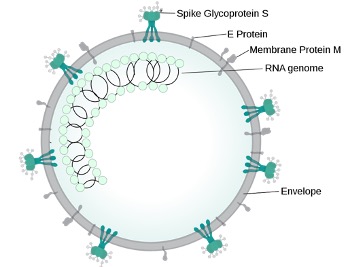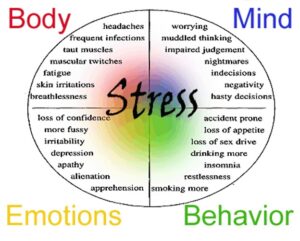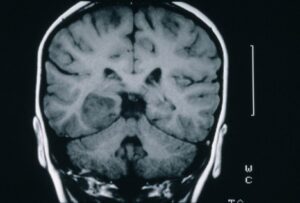
Figure 1: This is an image showing the main parts of the coronavirus, from the RNA genome in the center to the protruding S1 proteins used to enter cells. Researchers at the University of Washington Medical School found that these S1 proteins are able to cross the blood-brain barrier, a restrictive barrier to prevent the entrance of pathogens to the brain, in mice. This could help explain the mysterious neurological effects of COVID-19
Source: Wikimedia Commons
With almost 18 million cases in the US alone, the COVID-19 pandemic has yet to subside. It has been a source of physiological, social, economic, and political anguish for much of the past year, but the future seems promising as companies such as Pfizer and Moderna are in the final stages of vaccine development. And while many people are well aware of the most common effects and symptoms of the virus (e.g., shortness of breath and fatigue), many are not yet aware of the impacts the illness can have on the blood, heart, and brain (Mayo Clinic Staff, 2020). As mounting evidence has suggested that the virus can affect the brain, researchers at the University of Washington School of Medicine have begun taking steps to find out exactly why this happens (UW Medicine, 2020).
The coronavirus has a distinctive image attached to it. Derived from the latin word for crown, ‘coronam,’ it is named for the crown-like ‘thorns’ on its surface (Huizen, 2020). These thorns are known as ‘S1 proteins,’ a spike protein that acts to facilitate viral binding and entrance into host cells. Like other viruses, coronavirus uses infected cells to reproduce, spreading throughout the host to perform this process over and over again (Lu, 2020).
The coronavirus uses the host’s bloodstream to travel throughout the body. But surrounding our brain’s blood vessels is something called the ‘blood-brain barrier’ (BBB). In addition to maintaining constant nutrient, water, and hormone levels in the brain, the barrier’s purpose is to protect against circulating toxins and pathogens. Although highly effective, researchers at the University of Washington have found that the S1 protein is able to cross the BBB in mice (UW Medicine, 2020).
Detaching from the virus and crossing the BBB, S1 proteins can cause damage to the brain by generating inflammation. They cause the brain to release cytokines—small proteins that regulate immunity and inflammation—and other inflammatory products, which can result in a dangerous response called a ‘cytokine storm.’ A cytokine storm is when the immune system, upon seeing the virus, goes into overdrive to kill the invaders, causing the infected person to experience fatigue, brain fog, and other cognitive issues. Dr. William A. Banks, author of the study and professor at the University of Washington Medical School, said that his team saw this reaction with the HIV virus and ventured to investigate if COVID-19 caused the same response. The S1 protein and gp120 protein (the spike protein of HIV) are eerily similar. Both are glycoproteins—a class of proteins containing carbohydrate groups attached to a polypeptide chain—that can cross the BBB. And both can cause damage to brain tissue, potentially leading to long term effects (UW Medicine, 2020).
This study offers an additional explanation for respiratory symptoms, suggesting that the virus may enter and affect the respiratory-controlling part of the brain. This finding is corroborated by experiments which have found that S1 proteins are transported faster to the brain in males than in females, which could explain why males are more susceptible to severe COVID-19 outcomes.
The implications of the study are important towards a deeper understanding of the virus and its effects on different organ systems. Symptoms such as difficulty breathing are well-known within the scientific community and the public at large, but symptoms less obvious from a cursory glance may be far more dangerous and long lasting, especially when considering those related to the brain. Although the future seems bright as vaccines are right around the corner, we have yet to live in the pandemic-world long enough to experience the potential long-term effects of COVID-19. And as studies show that this respiratory illness can create problems in other parts of the body, scientists are hopeful that there are not more worse things to come (University of Washington Health Sciences/UW Medicine, 2020).
References
Mayo Clinic Staff. (2020, November 17). COVID-19 (coronavirus): Long-term effects. Mayo Clinic. Retrieved December 21, 2020 from https://www.mayoclinic.org/diseases-conditions/coronavirus/in-depth/coronavirus-long-term-effects/art-20490351.
University of Washington Health Sciences/UW Medicine. (2020, December 17). COVID-19 virus enters the brain, research strongly suggests: A new study shows how spike protein crosses the blood-brain barrier. ScienceDaily. Retrieved December 21, 2020 from www.sciencedaily.com/releases/2020/12/201217154046.htm.
Huizen, J. (2020, September 28). Why is it called coronavirus? MedicalNewsToday. Retrieved December 21, 2020 from https://www.medicalnewstoday.com/articles/why-is-it-called-coronavirus#why-is-it-called-coronavirus.
Lu, J. (2020, April 9). How coronavirus replicate inside you. Los Angeles Times. Retrieved December 21, 2020 from https://www.latimes.com/projects/how-coronavirus-invade-cells-replicates/.
Rhea, E.M., Logsdon, A.F., Hansen, K.M., Williams, L.M., Reed, M.J., Baumann, K.K., Holden, S.J., Raber, J., Banks, W.A., & Erickson, M.A. (2020, December 16). The S1 protein of SARS-CoV-2 crosses the blood–brain barrier in mice. Nature Neuroscience, 1-11. Retrieved December 21, 2020 from https://www.nature.com/articles/s41593-020-00771-8#citeas.
Related Posts
Fighting Hospital Hardships: An Intervention for Reducing Stress in Hospital Workers
Figure 1: This figure describes some of the symptoms of...
Read MoreInvestigating Obstructive Sleep Apnea (OSA) in African and Latin Americans from Chicago
This publication is in proud partnership with Project UNITY’s Catalyst Academy 2024...
Read MoreInnovation Beyond All Barriers: The Arrival of a Life-Saving Treatment
Figure 1:Magnetic resonance image (MRI) – coronal slice of a...
Read MoreSai Rayasam



